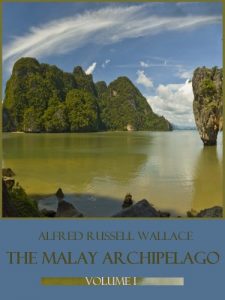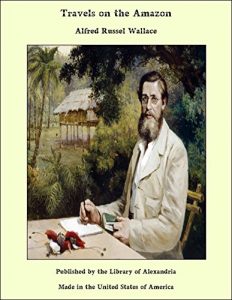Alfred Russel Wallace (1823 – 1913) was a British naturalist, explorer, geographer, anthropologist, and biologist. He is best known for independently conceiving the theory of evolution through natural selection; his paper on the subject was jointly published with some of Charles Darwin's writings in 1858.
He was considered the 19th century's leading expert on the geographical distribution of animal species and is sometimes called the "father of biogeography".
Mr. Wallace's travels on the Rio Negro and to the upper waters of the Orinoco, his adventurous ascent of the rapid river Uaupes, his observations on the natural history and the native tribes of the Amazon valley, are simply and naturally recorded in this volume. His assemblage of facts will be seen to form a broad basis for induction as to causes and modes of transformation of species. His return voyage bade fair to be his last, for the vessel in which he sailed took fire, and was completely destroyed, with a large proportion of Mr. Wallace's live animals and valuable specimens. Ten anxious days had to be spent in boats, tortured not only by shortness of food but by remembrances of the dangers encountered in obtaining valued specimens, now irretrievably lost. It was only after an eighty days' voyage that Mr. Wallace landed at Deal on the 18th of October, 1852. His " Travels on the Amazon and Rio Negro," published in the autumn of 1853, had an excellent reception, and after disposing of the collections which had been sent home previous to his return Mr. Wallace started for another tropical region, the Malay archipelago.
The volume now before us contains notes collected during four years' residence in this interesting and too little known district. It would be difficult to estimate how deeply science is indebted to wayside notes and jottings brought home by travellers those who devote their prime to foreign travel, not with the mere design of spending a few years in the gratification of a vacant curiosity, but who go forth with prepared minds, eager to observe all that would be likely to advance the interests of science; and the result has been the production of a class of works of travel, unsuited, indeed, to the mere literary lounger, but in which the man of science, or of cultivated understanding, will take a deep interest. The volume of Travels on the Amazon and Rio Negro, by Mr. A. R. Wallace, now before us, is a well marked example of this class, and one that will amply repay a careful perusal.
Written under circumstances of great discouragement, it nevertheless presents a mass of valuable observations, interesting to all true naturalists, as descriptive of a little known, though most luxuriant region. Mr. Wallace, who was most desirous “of seeing with his own eyes all those wonders which he had delighted to read of in the narratives of travellers,” was induced, by a perusal of Mr. Edwards' little book, “A Voyage up the Amazon,” to start on the same route, purposing to pay his expenses by making collections in natural history; which we are glad to say, for the sake of scientific enterprise, he succeeded in doing.
In describing an encounter with a jaguar Wallace writes:
"As I was walking quietly along I saw a large jet-black animal come out of the forest about twenty yards before me, which took me so much by surprise that I did not at first imagine what it was. As it moved slowly on, and its whole body and long curving tail came into full view in the middle of the road, I saw that it was a fine black jaguar. I involuntarily raised my gun to my shoulder, but remembering that both barrels were loaded with small shot, and that to fire would exasperate without killing him, I stood silently gazing. In the middle of the road he turned his head, and for an instant paused and gazed at me, but having, I suppose, other business of his own to attend to, walked steadily on, and disappeared in the thicket."
He was considered the 19th century's leading expert on the geographical distribution of animal species and is sometimes called the "father of biogeography".
Mr. Wallace's travels on the Rio Negro and to the upper waters of the Orinoco, his adventurous ascent of the rapid river Uaupes, his observations on the natural history and the native tribes of the Amazon valley, are simply and naturally recorded in this volume. His assemblage of facts will be seen to form a broad basis for induction as to causes and modes of transformation of species. His return voyage bade fair to be his last, for the vessel in which he sailed took fire, and was completely destroyed, with a large proportion of Mr. Wallace's live animals and valuable specimens. Ten anxious days had to be spent in boats, tortured not only by shortness of food but by remembrances of the dangers encountered in obtaining valued specimens, now irretrievably lost. It was only after an eighty days' voyage that Mr. Wallace landed at Deal on the 18th of October, 1852. His " Travels on the Amazon and Rio Negro," published in the autumn of 1853, had an excellent reception, and after disposing of the collections which had been sent home previous to his return Mr. Wallace started for another tropical region, the Malay archipelago.
The volume now before us contains notes collected during four years' residence in this interesting and too little known district. It would be difficult to estimate how deeply science is indebted to wayside notes and jottings brought home by travellers those who devote their prime to foreign travel, not with the mere design of spending a few years in the gratification of a vacant curiosity, but who go forth with prepared minds, eager to observe all that would be likely to advance the interests of science; and the result has been the production of a class of works of travel, unsuited, indeed, to the mere literary lounger, but in which the man of science, or of cultivated understanding, will take a deep interest. The volume of Travels on the Amazon and Rio Negro, by Mr. A. R. Wallace, now before us, is a well marked example of this class, and one that will amply repay a careful perusal.
Written under circumstances of great discouragement, it nevertheless presents a mass of valuable observations, interesting to all true naturalists, as descriptive of a little known, though most luxuriant region. Mr. Wallace, who was most desirous “of seeing with his own eyes all those wonders which he had delighted to read of in the narratives of travellers,” was induced, by a perusal of Mr. Edwards' little book, “A Voyage up the Amazon,” to start on the same route, purposing to pay his expenses by making collections in natural history; which we are glad to say, for the sake of scientific enterprise, he succeeded in doing.
In describing an encounter with a jaguar Wallace writes:
"As I was walking quietly along I saw a large jet-black animal come out of the forest about twenty yards before me, which took me so much by surprise that I did not at first imagine what it was. As it moved slowly on, and its whole body and long curving tail came into full view in the middle of the road, I saw that it was a fine black jaguar. I involuntarily raised my gun to my shoulder, but remembering that both barrels were loaded with small shot, and that to fire would exasperate without killing him, I stood silently gazing. In the middle of the road he turned his head, and for an instant paused and gazed at me, but having, I suppose, other business of his own to attend to, walked steadily on, and disappeared in the thicket."











